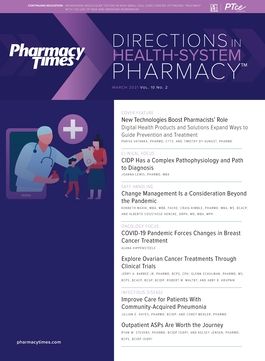Publication
Article
Pharmacy Practice in Focus: Health Systems
Outpatient ASPs Are Worth the Journey
Developing an antimicrobial stewardship program is arduous but valuable; commitment from leadership is the first step.
Antimicrobial stewardship program (ASP) development in the United States has expanded significantly over the past 2 decades, with 85% of acute-care hospitals demonstrating program that contain all of the CDC's core elements of antimicrobial stewardship.1
Yet, despite an ever-expanding understanding of inpatient antimicrobial stewardship practices, approximately 80% to 90% of human antibiotic consumption takes place in the outpatient setting.2 The new ambulatory standard from the Joint Commission for the Accreditation of Healthcare Organizations (TJC) took effect January 1, 2020. Since then, ASPs have focused on the use of antimicrobials in the outpatient setting.3 The addition of an outpatient ASP to a facility's armamentarium is both difficult and valuable, given several features of the setting that complicate efforts, including a lack of feasibility of tradition primary stewardship tactics, large volume of outpatient providers, and a vast array of services.
The quest for outpatient antimicrobial stewardship in the ambulatory setting may start with understanding 2 key documents: the CDC's "Core Elements of Outpatient Antimicrobial Stewardship" and the TJC's "Antimicrobial Stewardship in Ambulatory Health Care" standard.1 Both focus on 4 core elements of stewardship: leadership commitment; action in policy and practice; education; and data analysis and reporting.1,3
Leadership commitment. The success of any ASP can be sourced back to the commitment level of an institution's leadership, the prescribers within the institution, and the ASP team. Without institutional leadership commitment to the practice, effort and enthusiasm are unlikely to gain traction. Leadership commitment may be demonstrated in several ways. One of the most critical is through the designation of health-system and/or local leaders for ambulatory ASP.2,4 This should, ideally, be accompanied by dedicated practice time and the incorporation of clear expectations and specific responsibilities into job descriptions. Consider writing and publicly displaying a commitment to antimicrobial stewardship practices to demonstrate institutional commitment to patients receiving care.
Action in policy and practice. The first step toward designing and implementing interventions as an outpatient ASP is to define an annual target. Outpatient antimicrobial use takes place across an array of locations and specialties, including emergency departments, medical offices, retail clinics, and urgent-care facilities. It is important that programs focus on specific goals to allow for appropriate tracking of association metrics. Urgent-care visits have some of the highest rates of antimicrobial prescribing per patient encounter and should not be overlooked when designing ASP plans.5 One recent review of antimicrobial prescribing across a network of urgent-care clinics found that respiratory encounters accounted for 41.8% of all visits.6 Furthermore, 21.3% of visits for respiratory infections unlikely to benefit from antimicrobial therapy still resulted in an antibiotic prescription. When considering encounter-level outpatient ASP targets, genitourinary infections, respiratory, and skin and soft tissue likely represent the 3 most logical focus areas, with respiratory infections the most commonly studied target in the literature.5-11
The next step is to implement best practices that favorably affect antimicrobial prescribing pertaining to the established goal. One opportunity is to formalize delayed prescribing and watchful waiting processes, which have resulted in 60% or greater reductions in antibiotic use compared with patients given an immediate prescription.12,13 Another option is to implement evidence-based practice guidelines or protocols for appropriate prescribing of antimicrobials.3 Enhancing clinical decision support within the electronic medical record and requiring indication for antimicrobial prescriptions can also facilitate appropriate prescribing. However, there are barriers, including limitations in information (IT) support and resistance to change in prescriber workflow.
Education. Educational efforts that target both clinicians and patients are essential.1 It is critical that prescribers be made aware of the annual goal and provided tools to support it. Emerging literature has identified that many factors, beyond gaps in knowledge, contribute to inappropriate prescribing by clinicians.9 These can be emotional, financial, or social, including the belief that some patients may be impossible to satisfy without giving them an antibiotic prescription, the perceived correlation between antibiotic prescribing and value, and the potential for negative implications brought about by failure to prescribe antibiotics.9 Provider education should include a review of clinical content as well as communication tools and support to overcome psychosocial pressures for unnecessary antibiotic prescribing.1
Significant gaps in patient knowledge about appropriate antimicrobial use also represent a substantial opportunity.14 Give patients a clear rationale when antibiotics are not indicated, including the potential unintended consequences of antimicrobial use, such as adverse events, increased cost, infection-related complications, and resistance development.3 In addition to the prescriber-patient interaction, use educational materials, such as posters, pamphlets, and videos, to ensure that patients receive a consistent message. To address the perception of value when antibiotics are not indicated, provide patients with written instructions for symptomatic treatment and a contingency plan for follow-up if symptoms worsen.3
Data analysis and reporting. Tracking antimicrobial prescribing practices and providing regular feedback to clinicians are essential for both progress toward established goals and sustained culture change.3 Unfortunately, this element may be met with a host of barriers, such as a lack of IT support and limits surrounding data extraction. Moreover, it has been shown that a large portion of antimicrobial prescribing occurs because of nonvisit care, resulting in outpatient ASP efforts failing to target approximately half of antibiotic prescribing.15
Apply selected metrics to the established goals, including analysis of encounter types, percentage of visits resulting in an antimicrobial prescription, and prescribing rate by antimicrobial class.3 In addition to primary metrics, formalize a plan for counterbalance measures to track unforeseen complications that may arise from decreased antimicrobial use.3 Although the capability to thoroughly evaluate outpatient data is requisite, it is also imperative that these data are communicated regularly to providers. Prescriber-level interventions, such as dashboards and individualized letters, can promote individual behavioral change through peer comparison.9,16
Although the CDC core elements provide a road map for successful implementation of an outpatient ASP, there may be detours. ASPs in the early phases of outpatient implementation should perform a comparison of current performance with desired performance, through which gaps in practice can be identified. Begin improvements with high-impact, low-effort interventions. For items that require more effort, develop an action plan with a realistic timeline. Although the road to successful deployment may seem similar to the pursuit of the Holy Grail, the growth and progress that a program encounters along the way will make the journey worthwhile.
REFERENCES
1. CDC. Core elements of hospital antibiotic stewardship programs. Updated November 16, 2020. Accessed February 8, 2021. https://www.cdc.gov/antibiotic-use/core-elements/hospital.html
2. Sanchez GV, Fleming-Dutra KE, Roberts RM, Hicks LA. Core elements of outpatient antibiotic stewardship. MMWR Recomm Rep. 2016;65(6):1-12. doi:10.15585/mmwr.rr6506a1
3. The Joint Commission. R3 report issue 23: antimicrobial stewardship in ambulatory health care. Accessed February 8, 2021. https://www.jointcommission.org/standards/r3-report/r3-report-issue-23-antimicrobial-stewardship-in-ambulatory-health-care/
4. Quality Improvement Organizations. A field guide to antibiotic stewardship in outpatient settings. July 2018. Accessed February 8, 2021. https://qioprogram.org/sites/default/files/editors/141/C310_Field_Guide_20180730_FNL.pdf
5. Palms DL, Hicks LA, Bartoces M, et al. Comparison of antibiotic prescribing in retail clinics, urgent care centers, emergency departments, and traditional ambulatory care settings in the United States. JAMA Intern Med. 2018;178(9):1267-1269. doi:10.1001/jamainternmed.2018.1632
6. Stenehjem E, Wallin A, Fleming-Dutra KE, et al. Antibiotic prescribing variability in a large urgent care network: a new target for outpatient stewardship. Clin Infect Dis. 2020;70(8):1781-1787. doi:10.1093/cid/ciz910
7. Fleming-Dutra KE, Hersh AL, Shapiro DJ, et al. Prevalence of inappropriate antibiotic prescriptions among US ambulatory care visits, 2010-2011. JAMA. 2016;315(17):1864-1873. doi:10.1001/jama.2016.4151
8. White AT, Clark CM, Sellick JA, Mergenhagen KA. Antibiotic stewardship targets in the outpatient setting. Am J Infect Control. 2019;47(8):858-863. doi:10.1016/j.ajic.2019.01.027
9. Kohut MR, Keller SC, Linder JA, et al. The inconvincable patient: how clinicians perceive demand for antibiotics in the outpatient setting. Fam Pract. 2020;37(2):276-282. doi:10.1093/fampra/cmz066
10. Wattengel BA, DiTursi S, Schroeck JL, Sellick JA, Mergenhagen KA. Outpatient antimicrobial stewardship: targets for urinary tract infections. Am J Infect Control. 2020;48(9):1009-1012. doi:10.1016/j/ajic.2019.12.018
11. CDC. The core elements of outpatient antibiotic stewardship appendix. Accessed February 8, 2021. https://www.cdc.gov/antibiotic-use/community/pdfs/16_268900-A_CoreElementsOutpatient_appendix_508.pdf
12. Little P, Moore M, Kelly J, et al. Delayed antibiotic prescribing strategies for respiratory tract infections in primary care: pragmatic, factorial randomized controlled trial. BMJ. 2014;348:g1606. doi:10.1136/bmj.g1606
13. McCormick DP, Chonmaitree T, Pittman C, et al. Nonsevere acute otitis media: a clinical trial comparing outcomes of watchful waiting versus immediate antibiotic treatment. Pediatrics. 2005;115(6):1455-1465. doi:10.1542/peds.2004-1665
14. Seipel MBA, Prohaska ES, Ruisinger JF, Melton BL. Patient knowledge and experiences with antibiotic use and delayed antibiotic prescribing in the outpatient setting. J Pharm Pract. Published online: December 13, 2019. doi:10.1177/0897190019889427
15. Fischer MA, Mahesri M, Lii J, Linder JA. Non-infection-related and non-visit-based antibiotics prescribing is common among Medicaid patients. Health Aff (Millwood). 2020;39(2):280-288. doi:10.1377/hlthaff.2019.00545
16. Hallsworth M, Chadborn T, Sallis A, et al. Provision of social normal feedback to high prescribers of antibiotics in general practice: a pragmatic national randomized controlled trial. Lancet. 2016;387(10029):1743-1752. doi:10.1016/S0140-6736(16)00215-4
The Society of Infectious Diseases Pharmacists (SIDP) is an association of pharmacists and other allied healthcare professionals who are committed to promoting the appropriate use of antimicrobial agents and supporting practice, teaching, and research in infectious diseases. We aim to advance infectious diseases pharmacy and lead antimicrobial stewardship in order to optimize the care of patients. To learn more about SIDP, visit sidp.org.







